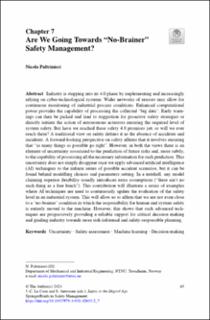| dc.contributor.author | Paltrinieri, Nicola | |
| dc.date.accessioned | 2024-03-22T12:44:09Z | |
| dc.date.available | 2024-03-22T12:44:09Z | |
| dc.date.created | 2024-01-17T13:22:31Z | |
| dc.date.issued | 2023 | |
| dc.identifier.isbn | 978-3-031-32632-5 | |
| dc.identifier.uri | https://hdl.handle.net/11250/3123848 | |
| dc.description.abstract | Industry is stepping into its 4.0 phase by implementing and increasingly relying on cyber-technological systems. Wider networks of sensors may allow for continuous monitoring of industrial process conditions. Enhanced computational power provides the capability of processing the collected “big data”. Early warnings can then be picked and lead to suggestion for proactive safety strategies or directly initiate the action of autonomous actuators ensuring the required level of system safety. But have we reached these safety 4.0 promises yet, or will we ever reach them? A traditional view on safety defines it as the absence of accidents and incidents. A forward-looking perspective on safety affirms that it involves ensuring that “as many things as possible go right”. However, in both the views there is an element of uncertainty associated to the prediction of future risks and, more subtly, to the capability of possessing all the necessary information for such prediction. This uncertainty does not simply disappear once we apply advanced artificial intelligence (AI) techniques to the infinite series of possible accident scenarios, but it can be found behind modelling choices and parameters setting. In a nutshell, any model claiming superior flexibility usually introduces extra assumptions (“there ain’t no such thing as a free lunch”). This contribution will illustrate a series of examples where AI techniques are used to continuously update the evaluation of the safety level in an industrial system. This will allow us to affirm that we are not even close to a “no-brainer” condition in which the responsibility for human and system safety is entirely moved to the machine. However, this shows that such advanced techniques are progressively providing a reliable support for critical decision making and guiding industry towards more risk-informed and safety-responsible planning. | en_US |
| dc.language.iso | eng | en_US |
| dc.publisher | Springer | en_US |
| dc.relation.ispartof | Safety in the Digital Age.Sociotechnical Perspectives on Algorithms and Machine Learning | |
| dc.rights | Navngivelse 4.0 Internasjonal | * |
| dc.rights.uri | http://creativecommons.org/licenses/by/4.0/deed.no | * |
| dc.title | Are We Going Towards “No-Brainer” Safety Management? | en_US |
| dc.title.alternative | Are We Going Towards “No-Brainer” Safety Management? | en_US |
| dc.type | Chapter | en_US |
| dc.description.version | publishedVersion | en_US |
| dc.identifier.doi | 10.1007/978-3-031-32633-2_7 | |
| dc.identifier.cristin | 2228675 | |
| cristin.ispublished | true | |
| cristin.fulltext | postprint | |
| cristin.qualitycode | 1 | |

